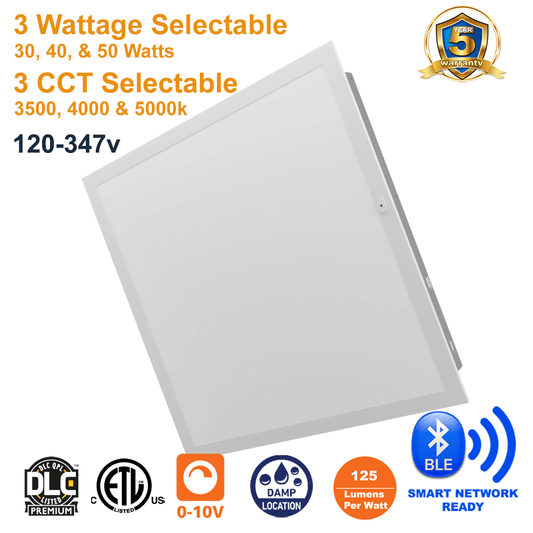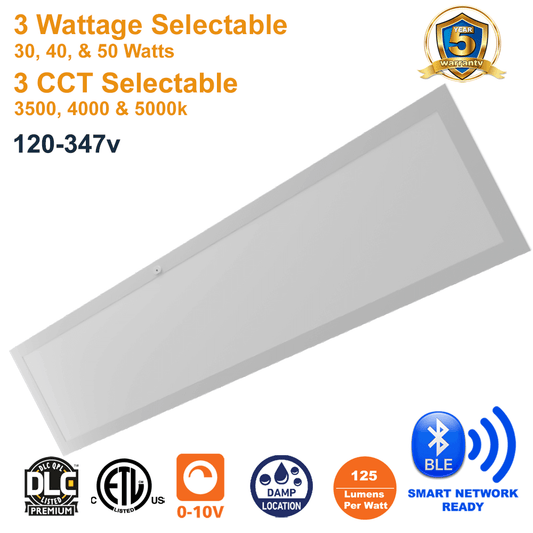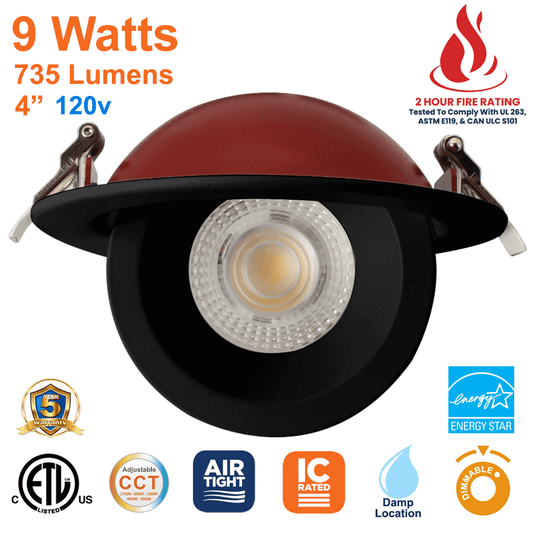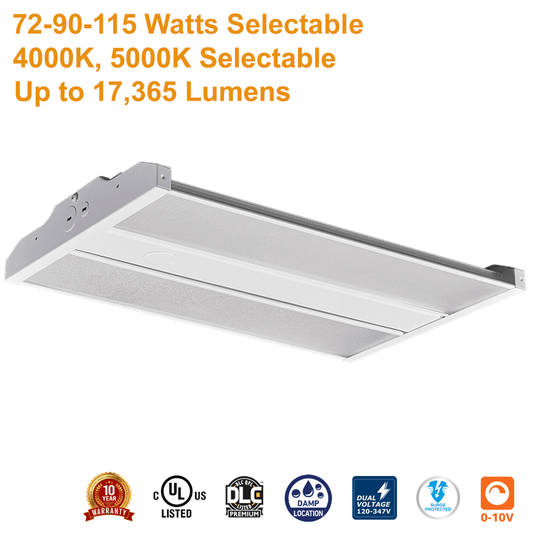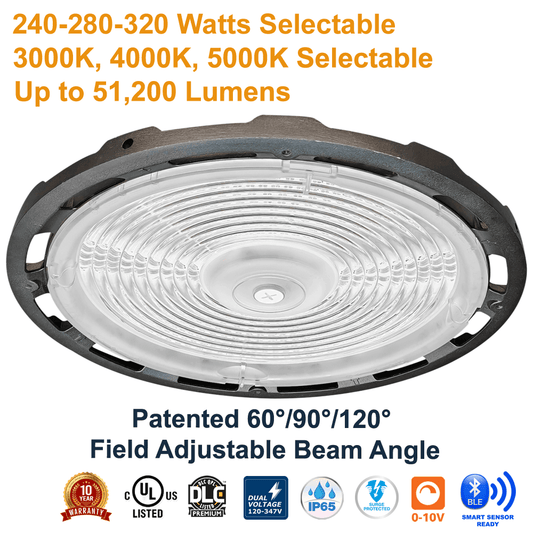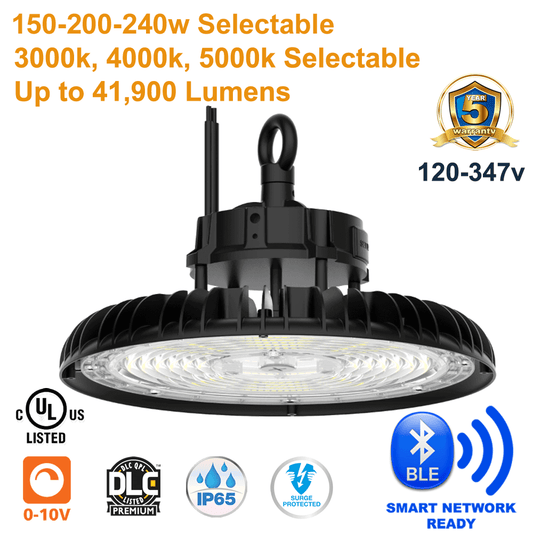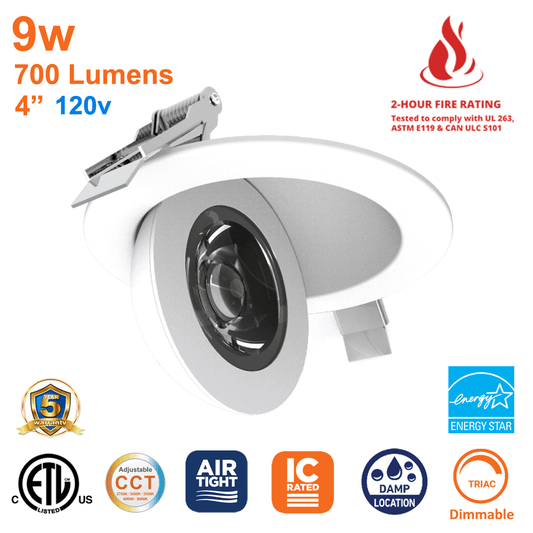In the vast world of illumination, two heavyweights continue their rivalry: LED Lighting and Metal Halide. But when we pull back the curtain and shine a light on their features and limitations, one clear winner emerges. "Behind the glow" of their luminescence, which one truly offers the best value for businesses, particularly those in the Commercial and Industrial sectors?
1. Energy Efficiency and Consumption
LED Lighting undoubtedly triumphs when it comes to energy efficiency. LEDs are up to 80% more efficient than their Metal Halide counterparts. When a Metal Halide bulb consumes 100 watts, approximately only 20% of this energy is converted into visible light. In contrast, LED lights convert almost 95% of their energy into light and a mere 5% into heat. For commercial spaces that require extensive lighting like warehouses and factories, this energy efficiency can translate to significant savings.
But, which type of LED lights save more energy compared to Metal Halide? LEDs such as LED High Bays and LED Flood Lights are specifically designed for spaces with high ceilings, where brightness and efficiency are paramount. With lesser energy consumption, they produce the same, if not more, light output than a typical Metal Halide fixture. Dive deeper into these savings with our article on uncovering remarkable energy savings with High Bay LED Lights.
2. Lifespan and Durability
Another significant difference between LEDs and Metal Halide lights is their lifespan. LEDs have a longer lifespan, averaging 50,000 to 100,000 hours of operation, and beyond. In contrast, a typical Metal Halide bulb lasts around 6,000 to 15,000 hours. This stark difference means fewer replacements, leading to more savings, especially in commercial settings like recreation facilities where lights often operate for extended hours.
Fun Fact: Some smart lights with LED technology even have features that notify users when they're nearing the end of their life cycle.
3. Maintenance and Replacement
Maintenance costs are another area where LEDs demonstrate their superiority. Given their longer lifespan, LED lights, such as the LED Panel Light and LED Corn Lamp, require less frequent replacements. Not only does this save on the cost of the fixture or bulb itself but also on the labour and materials associated with its replacement.
Metal Halide lights, on the other hand, degrade in light output much faster. This means even before their official end-of-life, the quality of light they provide can be considerably diminished, necessitating premature replacements. Understand this further with our complete guide to LED corn bulbs.
Moreover, while LEDs need minimal maintenance—mainly just cleaning the fixture and ensuring the drivers are functional, Metal Halide systems require more frequent checks. Their ballasts, capacitors, and other components can degrade or malfunction, causing the system to fail prematurely.
4. Warm-Up Time and Full Brightness
Another important factor, especially for businesses, is the speed at which lights achieve their full brightness. LED lights are instantaneous. Whether you're illuminating a building exterior or an indoor space, they light up without delay.
Metal Halide lights, conversely, take their time. It's not uncommon for these lights to take 5-15 minutes to reach their peak brightness. The reason for this warm-up period lies in the way Metal Halide lights function. They require an arc of electricity to pass through a mix of gases, including mercury, xenon, or argon and metal halides. This process requires a certain temperature to produce visible light. This delay can be problematic, particularly in scenarios where immediate lighting is crucial.
In this first section of the article, we've uncovered the technical differences that put LED lights ahead of their Metal Halide competitors. As we continue to explore the intricate world of commercial lighting and industrial lighting, we'll look deeper into environmental impacts, safety concerns, heat emissions, and more. Stick with us as we shed more light on this illuminating topic!
5. Environmental and Safety Concerns
When it comes to being environmentally conscious and prioritizing safety, LED lights again take the lead. First, let’s discuss the environmental angle. Metal Halide lamps contain harmful chemicals, including mercury. If not disposed of properly, these chemicals can leach into the environment, causing harm. In contrast, LED lights are more eco-friendly as they don’t contain such hazardous materials.
Additionally, Metal Halide ballasts and capacitors can contain harmful chemicals, which makes their disposal a concern. On the other hand, many LED lights are recyclable, further reducing their ecological footprint.
From a safety perspective, LED lights generate less heat compared to Metal Halide lights. This feature reduces the risk of burns and fires. Plus, with Networked Lighting Controls, facilities can have better control over LED lighting systems, further enhancing safety. Our blog on unveiling the benefits of networked lighting controls explains this in more detail.
6. Light Quality and Direction
Quality of light is crucial, especially in commercial settings. Colour Rendering Index (CRI) is a measure of how accurately a light source displays colors. LED lights tend to have a higher CRI compared to Metal Halide lights, resulting in truer, more vivid color representation. This is particularly useful in places like art galleries or retail stores where accurate color representation is crucial.
Furthermore, LED lights are available in a wider range of Colour Temperatures, giving users more flexibility in choosing the ambiance they want. Curious about the significance of colour temperature? Find out more in our post on what colour temperature is and why it’s important for lighting.
The direction of light is another distinguishing feature. LED lights are directional light sources, meaning they emit light in a specific direction. Metal Halide lights, on the other hand, are omnidirectional, releasing light in all directions. A significant amount of light is lost in the reflector and other parts of the fixture with Metal Halide systems. In contrast, LED’s directional nature ensures minimal light wastage.
7. Heat Emission and Climate Control Costs
One of the hidden costs of lighting is its impact on climate control. LED lights emit very little heat, thereby reducing the strain on air conditioning systems during warmer months. Places with extensive lighting, such as recreation facilities, can see a significant drop in cooling costs by transitioning to LEDs.
However, during colder months, the minimal heat emitted by LEDs means heating systems might need to work a tad harder compared to when using heat-emitting Metal Halide lights. That said, the energy efficiency and longer lifespan of LEDs usually outweigh this minor disadvantage.
In this segment, we've explored the environmental, safety, and quality facets of LED lights vis-à-vis Metal Halide lights. As we move forward, we’ll discuss more about the resilience, versatility, and compatibility of these lighting technologies. Stay tuned for more insights as we continue our journey "behind the glow"!
8. Resilience in Extreme Conditions
Both cold weather and physical vibrations can affect the performance and longevity of lighting systems. In chilly environments, LED lights shine the brightest. Unlike Metal Halides that can struggle to achieve full brightness in the cold, LEDs maintain consistent performance even in frosty settings. This makes them an excellent choice for outdoor applications, particularly in places like building exteriors exposed to cold Canadian winters.
As for vibration resistance, LEDs come out on top again. Due to their solid-state construction, they are less vulnerable to damage from physical shocks or vibrations, making them ideal for industrial settings like factories where machinery might cause constant vibrations.
9. Flickering, Dimming, and Switching
Flickering can be both annoying and harmful to our eyes. It's more often seen in Metal Halide lighting, especially as they near the end of their lifespan. LED lights, especially when paired with quality networked lighting controls, offer a flicker-free experience.
When it comes to dimming, LEDs provide more flexibility. Many LED lights are dimmable, allowing users to adjust brightness as needed. Metal Halides, on the other hand, are rarely dimmable. Dimmable Metal Halide lights can suffer from a shortened lifespan when dimmed. For an in-depth look at LED dimming technologies, explore our guide on 0-10V dimming.
Frequent switching on and off can diminish the lifespan of Metal Halide lights. LEDs? They remain unaffected by frequent switching, ensuring their longevity isn’t compromised.
10. Compatibility with Lighting Controls
"Behind the glow" of modern lighting is the growing emphasis on smart controls and automation. And in this realm, LEDs clearly dominate. They are inherently more compatible with various control systems, including wireless networked lighting controls. Pairing LEDs with systems like Bluetooth Low Energy powered networked lighting controls results in even greater energy reduction and improved user comfort.
Metal Halide lights, due to their older technology, aren’t as seamlessly integrated with advanced lighting control systems. So, if you're considering an upgrade to a smart lighting system, LEDs combined with modern networked lighting controls are the way to go.
In this section, we took a deeper look into the operational advantages of LED lighting. From resilience in extreme conditions to seamless compatibility with advanced controls, the benefits of LEDs over Metal Halides are evident. As technology continues to evolve, embracing the potential of LEDs for commercial lighting and industrial lighting seems not just wise, but essential. Stay with us for the concluding segment as we wrap up our comprehensive comparison.
11. Environmental and Safety Concerns
Beyond their superior performance, LED lights are also champions in environmental and safety considerations. Metal Halide lamps and their ballasts and capacitors contain harmful chemicals. Notably, they have a trace of mercury, which poses an environmental risk when disposed of improperly.
LEDs, in contrast, contain no toxic materials and are 100% recyclable. This helps reduce their carbon footprint, making them a friendlier choice for our planet. Furthermore, they reduce greenhouse gas emissions due to their superior energy efficiency.
From a safety perspective, LED lights run cooler than Metal Halide lights, minimizing the risks of burns and fires. The potential for exploding bulbs, which exists with older Metal Halide technologies, is non-existent with LEDs.
12. Size, Light Direction, and Heat Emission
In terms of size, LED lights are more compact than their Metal Halide counterparts. This allows for a more streamlined look and can be advantageous in spaces where aesthetics or space-saving is a priority.
Light direction is another significant advantage for LEDs. LED lights emit light in a specific direction, which means less light is wasted. This contrasts with Metal Halides, which disperse light in all directions, requiring reflectors to direct the light. Even then, a good portion of light is lost in Metal Halide reflectors.
When talking about heat, Metal Halide lights emit a considerable amount, which can increase air conditioning costs in indoor settings. LED lights emit very little heat. So, not only will you save on lighting costs, but your HVAC system will also thank you.
13. The Final Verdict
The extensive comparison leads us to an unequivocal conclusion: LED lights, particularly those tailored for commercial lighting and industrial lighting applications, far outshine Metal Halide lights in virtually every aspect. Whether it's energy efficiency, longevity, maintenance, environmental impact, or adaptability with modern technologies like networked lighting controls, LEDs emerge as the clear winner.
For businesses and industries, transitioning to LED is not just about tapping into modern lighting; it's an investment in sustainability, efficiency, and future-readiness.
"Behind the glow" of every LED is a promise of quality, longevity, and unparalleled performance. As we move forward in this age of technological advancements, it's evident that LEDs are not just the future; they are the now.
Thank you for joining us on this comprehensive journey. For more insights into the world of LEDs, and to explore our diverse range, do visit our blog and lighting store. We're here to light up your world, one LED at a time.











